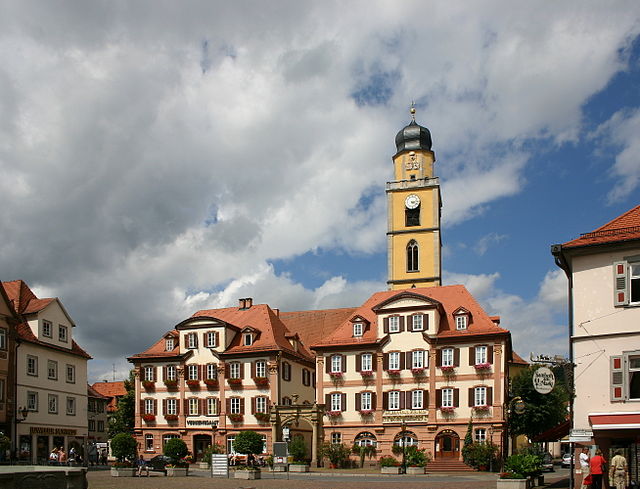Spa, Teutonic Order Castle & Stuppacher Madonna in the Tauber Valley
Bad Mergentheim in the Taubertal, Germany is famous for its spa, the Teutonic Order (Deutschorden) Castle and Museum, and the Stuppacher Madonna by Matthias Grünewald.

Bad Mergentheim in Germany is a prosperous town of close to 23,000 inhabitants. For tourists, it has a dual role as spa resort on the right bank of the Tauber and the historical center on the left bank.
During the 13th century, the counts of Hohenlohe gave much of Mergentheim to the newly established Teutonic Order. (The Dominicans and Order of St John also had a presence in town.) It was only in 1525 that the order really took control of the town when they established their new head quarters here. The wealthy order was responsible for most of the historical sights in town.
After the forced disbandment of the Teutonic Order in 1809, Mergentheim seemed destined to follow the route of so many others in the region into gentle decline. However, in 1826, the chance discovery of Europe’s strongest sodium sulfate and bitter-water springs in the town saw “Bad” (Spa) added to the town name and enduring prosperity assured.
Bad Mergentheim Tourist Office
Tourist-Information, Marktplatz 3, 97980 Bad Mergentheim, Germany, tel 07931-57131.
Bad Mergentheim has the full cultural program usually associated with a spa resort.
Top Sights to See in Bad Mergentheim Old Town
Bad Mergentheim has a lovely old town located on the left bank of the Tauber River. The large Marktplatz (Market Square) is dominated by the Renaissance Rathaus (Town Hall), which divided the oblong square in two. It was originally erected in 1564 but altered through the centuries.
To the north, the Münster St Johannes (Minster St John), Kirchgasse, was built by the Johanniterorden (Order of St John) in the 13th century. It has original wall paintings from the 13th to 16th centuries.
To the south, at Marktplatz 7, is the Mörikehaus where popular poet Eduard Mörike lived from 1844 to 1851. The nearby Marienkirche (St Mary’s), Hans-Heinrich-Ehrler-Platz, was erected by the Dominican Order during the 14th century. Especially noteworthy are the monumental tomb of Grand Master Walter von Cronberg (died 1543) from the studio of Peter Vischer and a wood-carved altar of the death of Mary from the studio of Tilman Riemenschneider.
The main sight in Bad Mergentheim is the Deutschordenschloss (Castle of the Teutonic Order).
Bad Mergentheim’s Spa Town
The spa facilities of Bad Mergentheim are on the right bank of the Tauber River. Despite the unfortunate route of the railway line, the Kurpark (Spa Park) with over 2,000 trees and a million flowers is considered one of the ten best of its kind in Germany.
Most of Bad Mergentheim’s spa-related facilities are in the northeastern edges of this park. The 1930s Wandelhalle (Pump Station) is used for the daily concerts (see Culture). Nearby is the Trinktempel (Drinking Temple) which plays an integral role in Trinkkur (Drinking Cure). Here the salty water of four of the springs is drunk – it supposedly helps with various stomach and intestine problems.
The Kurkolonade is an upscale shopping complex that gives a good indication of what people on weeklong cures like to buy – mostly expensive clothes and jewelry. In the Haus der Kurgaste, are the medical facilities and nearby is the Klanggarten (Sounds Garden).
Behind the Musikpavillion (Music Pavilion) with Wasserspiele (Musical Fountains) is the Rosengarten (rose garden) and a small Japanese garden.
Across the road is the spa Bade- und Wellnesspark Solymar, Erlenbachweg, tel 07931-965-680. It has five pools ranging in temperature from 27 to 34°C/80 to 93°F, wave machines, slides, facilities suitable for small children, and a range of saunas and steam baths. Opening hours are Monday from 1 to 6 pm, Tuesday to Friday from 10am to 10 pm, and weekends from 9 am to 7:30 pm. Admission is from €8 for two hours without sauna to €14 for a full day with all facilities.
Further Afield: Stuppacher Madonna
Around 6 km/4 miles from Bad Mergentheim’s old town in the suburb Stuppach is a small, unremarkable chapel that houses a remarkable painting, the Stuppacher Madonna, Matthias-Grünewald-Straße 45, 97980 Bad Mergentheim-Stuppach , tel 07931-2605.
This painting of Mary with Child was removed from the Maria Schnee Kapelle in Aschaffenburg during the 1525 Peasants’ War. It remained in the hands of the Teutonic Order until it came to this chapel in 1812.
The Stuppacher Madonna was long thought to be the work of Rubens. Only in 1908 was it recognized as one of the pieces from the Marienaltar (Mary Altar) and the 1519 work of the great German Renaissance painter Matthias Grünewald. (A second piece of the altar is in Freiburg, while Aschaffenburg only has copies.)
Opening hours of the chapel in Stuppach are Tuesday to Sunday in November from 11 am to 4 pm, in March and April from 10 am to 5 pm, and from May to October from 9:30 am to 5:30 pm. Admission is €1.50.
Next: The top sight in Bad Mergentheim is the Deutschordenschloss (Teutonic Order Castle) while upstream in Weikersheim on of the finest Renaissance palaces in Germany can be seen.
Further Destinations & Information on the Tauber Valley in Germany
- Introduction and Transportation in the Liebliches Taubertal
- Wertheim – Outlet mall shopping at the confluence of the Tauber and Main Rivers.
- Tauberbischofsheim & Lauda Königshofen – Half-Timbered Townscapes
- Bad Mergentheim – Old Town, Spa & Stuppacher Madonna
- Deutschordenschloss – Teutonic Order Castle in Bad Mergentheim
- Weikersheim (Renaissance Schloss) & Röttingen
- Creglingen – Riemenschneider Altar & Thimble Museum
- Hotels & Restaurants – Where to Sleep and Eat in the Tauber Valley
- Tauber Valley Cultural Events and Outdoor Adventures





